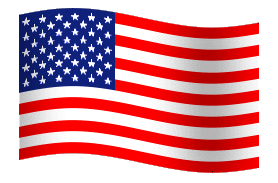
Betsy Ross and the American Flag
AFFIDAVIT DATED JULY 31, 1871
Affidavit of Rachel Fletcher, a daughter
of Elizabeth Claypoole (Betsy Ross)
I remember having heard my mother Elizabeth Claypoole say frequently that she, with her own hands, (while she was the widow of John Ross,) made the first Star-spangled Banner that ever was made. I remember to have heard her also say that it was made on the order of a Committee, of whom Col. Ross was one, and that Robert Morris was also one of the Committee. That General Washington, acting in conference with the committee, called with them at her house. This house was on the North side of Arch Street a few doors below Third Street, above Bread Street, a two story house, with attic and a dormer window, now standing, the only one of the row left, the old number being 89; it was formerly occupied by Daniel Niles, Shoemaker. Mother at first lived in the house next East, and when the war came, she moved into the house of Daniel Niles. That it was in the month of June 1776, or shortly before the Declaration of Independence that the committee called on her. That the member of the committee named Ross was an uncle of her deceased husband. That she was previously well acquainted with Washington, and that he had often been in her house in friendly visits, as well as on business. That she had embroidered ruffles for his shirt bosoms and cuffs, and that it was partly owing to his friendship for her that she was chosen to make the flag. That when the committee (with General Washington) came into her store she showed them into her parlor, back of her store; and one of them asked her if she could make a flag and that she replied that she did not know but she could try. That they then showed her a drawing roughly executed, of the flag as it was proposed to be made by the committee, and that she saw in it some defects in its proportions and the arrangement and shape of the stars. That she said it was square and a flag should be one third longer than its width, that the stars were scattered promiscuously over the field, and she said they should be either in lines or in some adopted form as a circle, or a star, and that the stars were six-pointed in the drawing, and she said they should be five pointed. That the gentlemen of the committee and General Washington very respectfully considered the suggestions and acted upon them, General Washington seating himself at a table with a pencil and paper, altered the drawing and then made a new one according to the suggestions of my mother. That General Washington seemed to her to be the active one in making the design, the others having little or nothing to do with it. That the committee then requested her to call on one of their number, a shipping merchant on the wharf, and then adjourned. That she was punctual to her appointment, and then the gentleman drew out of a chest an old ship's color which he loaned her to show her how the sewing was done; and also gave her the drawing finished according to her suggestions. That this drawing was done in water colors by William Barrett, an artist, who lived on the North side of Cherry Street above Third Street, a large three story brick house on the West side of an alley which ran back to the Pennsylvania Academy for Young Ladies," [note missing open quotation mark, probably meant before "Pennsylvania Academy" --Webmaster] kept by James A. Neal, the best school of the kind in the city at that time. That Barrett only did the painting, and had nothing to do with the design. He was often employed by mother afterwards to paint the coats of arms of the United States and of the States on silk flags. That other designs had also been made by the committee and given to other seamstresses to make, but that they were not approved. That mother went diligently to work upon her flag and soon finished it, and returned it, the first star-spangled banner that ever was made, to her employers, that it was run up to the peak of one of the vessels belonging to one of the committee then lying at the wharf, and was received with shouts of applause by the few bystanders who happened to be looking on. That the committee on the same day carried the flag into the Congress sitting in the State House, and made a report presenting the flag and the drawing and that Congress unanimously approved and accepted the report. That the next day Col. Ross called upon my mother and informed her that her work had been approved and her flag adopted, and he gave orders for the purchase of all the materials and the manufacture of as many flags as she could make. And that from that time forward, for over fifty years she continued to make flags for the United States Government.
I believe the facts stated in the foregoing Article entitled "The First American Flag and Who Made It," are all strictly true. This affidavit having been signed by Rachel Fletcher with violet ink, the signature has faded, but is at this time, Seventh Month 24th, 1908, still plainly legible.
Rachel Fletcher
I, Mary Fletcher Wigert, daughter of the said Rachel Fletcher, recognize the signature in the rectangular space outlined in black above, as the signature of my mother Rachel Fletcher.
Mary Fletcher Wigert
Signed in the presence of Mary W. Miller Philadelphia Seventh Mo. 24th, 1908
State of New York
City of New York SS
On the 31st day of July A.D. 1871. Before me the subscriber a Notary Public in and for the Commonwealth of New York, duly commissioned, residing in the said City of New York, personally appeared the above named Rachel Fletcher, who being duly affirmed did depose and say that the statements above certified to by her are all strictly true according to the best of her knowledge and belief, and that she is a daughter of Elizabeth Claypoole. Affirmed and subscribed before me the day and year aforesaid. Witness my hand and Notarial Seal.
Th. J. McEvily
Notary Public City & Co. New York



